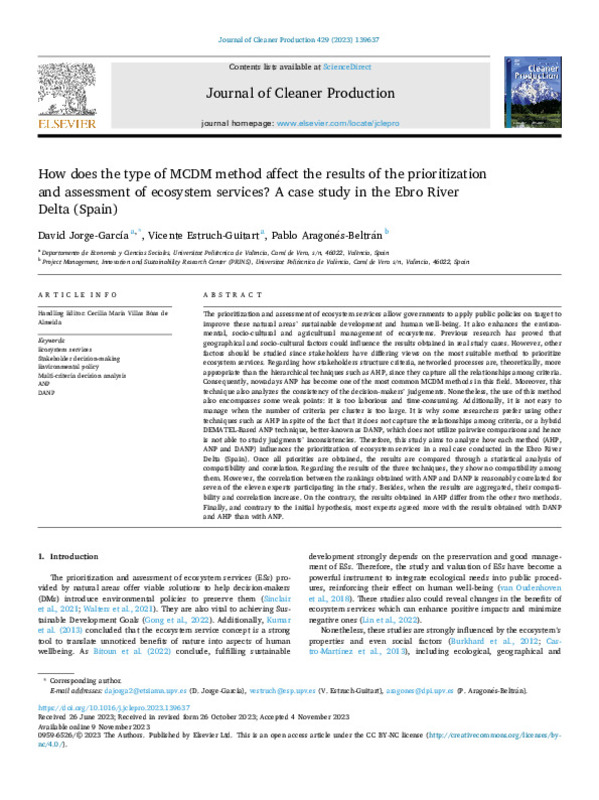JavaScript is disabled for your browser. Some features of this site may not work without it.
Buscar en RiuNet
Listar
Mi cuenta
Estadísticas
Ayuda RiuNet
Admin. UPV
How does the type of MCDM method affect the results of the prioritization and assessment of ecosystem services? A case study in the Ebro River Delta (Spain)
Mostrar el registro sencillo del ítem
Ficheros en el ítem
| dc.contributor.author | Jorge-García, David
|
es_ES |
| dc.contributor.author | Estruch-Guitart, Vicente
|
es_ES |
| dc.contributor.author | Aragonés-Beltrán, Pablo
|
es_ES |
| dc.date.accessioned | 2024-01-19T19:02:45Z | |
| dc.date.available | 2024-01-19T19:02:45Z | |
| dc.date.issued | 2023-12-01 | es_ES |
| dc.identifier.issn | 0959-6526 | es_ES |
| dc.identifier.uri | http://hdl.handle.net/10251/202041 | |
| dc.description.abstract | [EN] The prioritization and assessment of ecosystem services allow governments to apply public policies on target to improve these natural areas' sustainable development and human well-being. It also enhances the environmental, socio-cultural and agricultural management of ecosystems. Previous research has proved that geographical and socio-cultural factors could influence the results obtained in real study cases. However, other factors should be studied since stakeholders have differing views on the most suitable method to prioritize ecosystem services. Regarding how stakeholders structure criteria, networked processes are, theoretically, more appropriate than the hierarchical techniques such as AHP, since they capture all the relationships among criteria. Consequently, nowadays ANP has become one of the most common MCDM methods in this field. Moreover, this technique also analyzes the consistency of the decision-makers' judgements. Nonetheless, the use of this method also encompasses some weak points: it is too laborious and time-consuming. Additionally, it is not easy to manage when the number of criteria per cluster is too large. It is why some researchers prefer using other techniques such as AHP in spite of the fact that it does not capture the relationships among criteria, or a hybrid DEMATEL-Based ANP technique, better-known as DANP, which does not utilize pairwise comparisons and hence is not able to study judgments¿ inconsistencies. Therefore, this study aims to analyze how each method (AHP, ANP and DANP) influences the prioritization of ecosystem services in a real case conducted in the Ebro River Delta (Spain). Once all priorities are obtained, the results are compared through a statistical analysis of compatibility and correlation. Regarding the results of the three techniques, they show no compatibility among them. However, the correlation between the rankings obtained with ANP and DANP is reasonably correlated for seven of the eleven experts participating in the study. Besides, when the results are aggregated, their compatibility and correlation increase. On the contrary, the results obtained in AHP differ from the other two methods. Finally, and contrary to the initial hypothesis, most experts agreed more with the results obtained with DANP and AHP than with ANP. | es_ES |
| dc.description.sponsorship | Funding for open access charge: CRUE-Universitat Politecnica de Valencia. We would like to thank all the farmers, technicians and organizations that have participated as experts in this study. | es_ES |
| dc.language | Inglés | es_ES |
| dc.publisher | Elsevier | es_ES |
| dc.relation.ispartof | Journal of Cleaner Production | es_ES |
| dc.rights | Reconocimiento - No comercial (by-nc) | es_ES |
| dc.subject | Ecosystem services | es_ES |
| dc.subject | Stakeholder decision-making | es_ES |
| dc.subject | Environmental policy | es_ES |
| dc.subject | Multi-criteria decision analysis | es_ES |
| dc.subject | ANP | es_ES |
| dc.subject | DANP | es_ES |
| dc.subject.classification | ECONOMIA, SOCIOLOGIA Y POLITICA AGRARIA | es_ES |
| dc.subject.classification | PROYECTOS DE INGENIERIA | es_ES |
| dc.title | How does the type of MCDM method affect the results of the prioritization and assessment of ecosystem services? A case study in the Ebro River Delta (Spain) | es_ES |
| dc.type | Artículo | es_ES |
| dc.identifier.doi | 10.1016/j.jclepro.2023.139637 | es_ES |
| dc.rights.accessRights | Abierto | es_ES |
| dc.contributor.affiliation | Universitat Politècnica de València. Escuela Técnica Superior de Ingenieros Industriales - Escola Tècnica Superior d'Enginyers Industrials | es_ES |
| dc.contributor.affiliation | Universitat Politècnica de València. Escuela Técnica Superior de Ingeniería Agronómica y del Medio Natural - Escola Tècnica Superior d'Enginyeria Agronòmica i del Medi Natural | es_ES |
| dc.description.bibliographicCitation | Jorge-García, D.; Estruch-Guitart, V.; Aragonés-Beltrán, P. (2023). How does the type of MCDM method affect the results of the prioritization and assessment of ecosystem services? A case study in the Ebro River Delta (Spain). Journal of Cleaner Production. 429:1-16. https://doi.org/10.1016/j.jclepro.2023.139637 | es_ES |
| dc.description.accrualMethod | S | es_ES |
| dc.relation.publisherversion | https://doi.org/10.1016/j.jclepro.2023.139637 | es_ES |
| dc.description.upvformatpinicio | 1 | es_ES |
| dc.description.upvformatpfin | 16 | es_ES |
| dc.type.version | info:eu-repo/semantics/publishedVersion | es_ES |
| dc.description.volume | 429 | es_ES |
| dc.relation.pasarela | S\502963 | es_ES |
| dc.contributor.funder | Universitat Politècnica de València | es_ES |
| dc.subject.ods | 06.- Garantizar la disponibilidad y la gestión sostenible del agua y el saneamiento para todos | es_ES |
| dc.subject.ods | 14.- Conservar y utilizar de forma sostenible los océanos, mares y recursos marinos para lograr el desarrollo sostenible | es_ES |
| dc.subject.ods | 15.- Proteger, restaurar y promover la utilización sostenible de los ecosistemas terrestres, gestionar de manera sostenible los bosques, combatir la desertificación y detener y revertir la degradación de la tierra, y frenar la pérdida de diversidad biológica | es_ES |








